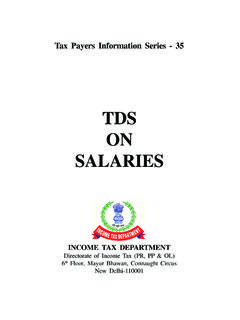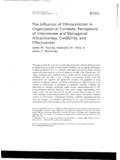Transcription of ROYALTY AND FEES FOR TECHNICAL SERVICES
1 INCOME TAX DEPARTMENTD irectorate of Income Tax (PR, PP & OL)6th Floor, Mayur Bhawan, Connaught Circus,New Delhi-110001 TAX PAYERS INFORMATION SERIES 44 ROYALTYANDFEES FOR TECHNICALSERVICESThis publication should not be construed as anexhaustive statement of the Law. In case of doubt,reference should always be made to the relevantprovisions of the Income Tax Act, 1961, Income TaxRules, 1962, Wealth Tax Act, 1957 and Wealth TaxRules, 1957, and, wherever necessary, to theNotifications issued from time to of technology is an important aspect of internationaltrade and investment. Transfer and sharing of intellectual propertyrights and providing managerial , TECHNICAL or professional servicesetc.
2 Are important means of such technology transfer. Indian industryand service providers have of late been increasing entering intoagreements with foreign firms so as to access such cutting-edge,technology with a -view to upgrade themselves and remaininternationally competitive. Though outward flow of royaltypayments remain a overwhelming trend in India, inward flow ofroyalty receipts have also been seen of late. These point to anincreasing technological embrace by the Indian Taxation Avoidance Agreements (DTAAs) areprimarily an agreement entered into between two countries, withthe basic objective is to promote and foster economic trade andinvestment between the two contracting countries by avoiding doubletaxation.
3 Taxation of royalties and fees for TECHNICAL servicescontinues to be an important area of these DTAAs, based primarilyon two models- the UN model and the OECD model. But despiteDTAAs, disputes often arise due to divergence in the interestsbetween the taxpayers and the tax-collectors. These disputes arealso due to the handicap to arrive at a common interpretation of thedefinition of ROYALTY or TECHNICAL service, differences between thedomestic laws, either common or civil laws characterization of theincome classification, forms of underlying contracts etc. Frequentand ever changing technology often presents its own challengesresulting in disputes due to form and multi-dimensional characterof intellectual property rights or TECHNICAL work by Shri Sanjay Kumar, CIT (IT & CT), CBDT,earlier DIT (Intl.)
4 Taxn. & Transfer Pricing), Kolkata and Shri NilayBaran Som. Dy. Director, DTRTI, Kolkata, is an attempt to bringout some of these underlying issues in a succinct, yet clear, NoCHAPTER 1 Introduction1 CHAPTER 2 Taxation of ROYALTY and fees For15 TECHNICAL SERVICES in India-The LegalFrameworkCHAPTER 3 Royalties and FTS: Model Conventions30and the Indian TreatiesCHAPTER 4 TDS on ROYALTY from Income of42 Non-ResidentsCHAPTER 5 Taxation of ROYALTY and fees for 56 TECHNICAL ServicesIssues and DecisionsCHAPTER 6 ROYALTY and Transfer Pricing95 CHAPTER 7 ROYALTY and fees for Technical101 SERVICES and Provisions of theProposed Direct Tax CodeCHAPTER 8 Frequently Asked Questions on (FAQs)109 ROYALTY & FTS and Related MattersAnnexure 1-16121 Acknowledgements199 Notes:200 New and emerging issues on the subject have also been exploredand so presented as to make them easy to understand.
5 It is hopedthat this book would increase the awareness of the taxpayers onthe important issues of ROYALTY and fees for TECHNICAL service in thefield of international taxation and transfer pricing. Keeping in viewthe objective of the Directorate of Income Tax (PR, PP and OL)to educate taxpayers regarding various issues directly or indirectlyrelated to them. FAQs have also been added on the subject. It ishoped that this publication will prove useful to the Directorate of Income Tax (PR, PP and OL) welcomesany suggestion to further improve this DelhiDated: (R. M. Garg)Director of Income Tax (PR, PP & OL)CHAPTER 1 IntroductionTechnology transfer to the developing countries is central totheir ability to compete in the global economy and to narrow downthe technological gaps they face compared to the developedcountries.
6 Technology transfer is a comprehensive term, coveringmechanisms for shifting information across borders and its effectivediffusion into recipient economies. It ordinarily refers to numerouscomplex processes, ranging from innovation, marketing of thetechnology, its absorption and imitation. Included in these processesare trade, and investment policies that can affect the terms ofaccess to knowledge. Successful transfer of technology involvingpartners from developed and developing countries require financing,as well as home and host country policy measures to stimulate thetransfer and local adaptation of technology. Some of the majorchannels of technology transfer are trade in goods and SERVICES ,foreign direct investment (FDI), technology licensing etc.
7 In thisregard, patents, copyrights, trademarks serve as direct means ofinformation of Technology TransferNormally, three ways are used by the firms to acquiretechnology. These three modes of transfer of technology are closelyinterrelated and supportive of each other. The modes or channelsare:a)through trade: international technology transfer throughtrade occurs when a country imports higher-qualityintermediary goods to use in its own production processes;32b)through investment: a firm can set up a foreignestablishment to exploit the technology itself. It can be doneby setting up a branch or a subsidiary in the foreign Direct Investment (FDI) is the most important meansof transferring technology to developing countries.
8 Technologytransfer through FDI generates more benefits as comparedto the other modes of transfer. This is because an investmentnot only comprises the technology but with it travels the entiremanagement experience and entrepreneurial abilities of thefirm. These can be transferred by training programmes andactual work. Further, there are technologies and other know-how used by affiliates of multinational enterprises (MNE)which are not always available in the market, but can betransported only through the MNE itself. Even otherwise,some technologies, even if available in the market, may bemore costly to a third party than to the affiliate of the )through licences: sometimes a firm may license itstechnology to another firm abroad which uses it to upgradeits own production.
9 Licensing sometimes is more desirablethan the FDI route. Various tariff and non-tariff barriers,government policies or the general investment climate canmake export a costly option. Also, for certain industry sectors,notably in SERVICES , trade can be a complicated means toexploit a firm s superior technology or managementcapabilities overseas. In such cases, a firm who owns atechnology may choose to license its technology to a in IndiaAfter economic liberalization, India has been witnessing athrust in Foreign Direct Investment (Figure ) since the : Top 20 FDI Host Countries 2000-09 The FDIs for India over a period of time is given in Table : Inward and Outward FDI of IndiaInward FDIO utward FDIY earsInPercentageInPercentage ofMillionof NationalMillionNationalUS $GrossUS $Gross CapitalCapitalFormationFormation1995-200 43 501---200842 : UNCTAD World Investment Report, 2010 Source.
10 UNCTAD World Investment Report, Report calculates that India s country ranking improvedfrom to 67 in 2009 from 82 in 2008, but slid to 97 in of the key recipients (sector-wise) of the FDI are shown inFigure : India: Sectors attracting Highest FDI InflowsAnother development of the recent times is that India whichitself is a recipient of ROYALTY has been investing in other countries,and so of late there has been some receipt of ROYALTY and licensefees by India (Figure ).Figure : Receipt of ROYALTY & License FeesRoyalty Payments by IndiaWith the increased FDI, it is expected that Indian firms wouldbe using more and more improved technology for its growingindustrial production and SERVICES .

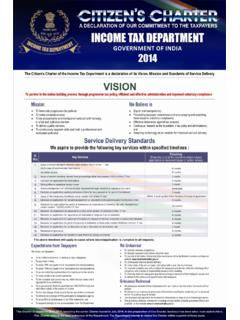
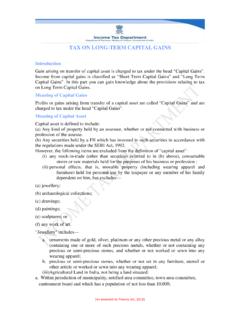
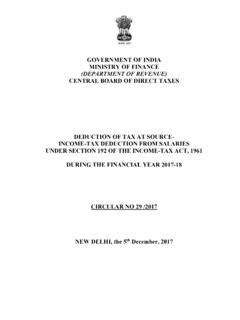


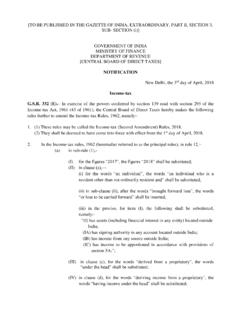
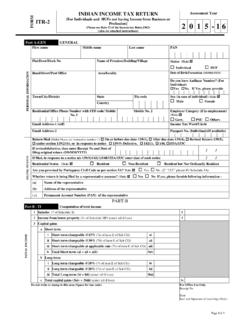
![FORM NO. 3CA [See rule 6G(1)(a)] Audit report …](/cache/preview/5/e/9/7/6/b/7/4/thumb-5e976b74d05a63207c471fc48a86f3e5.jpg)
